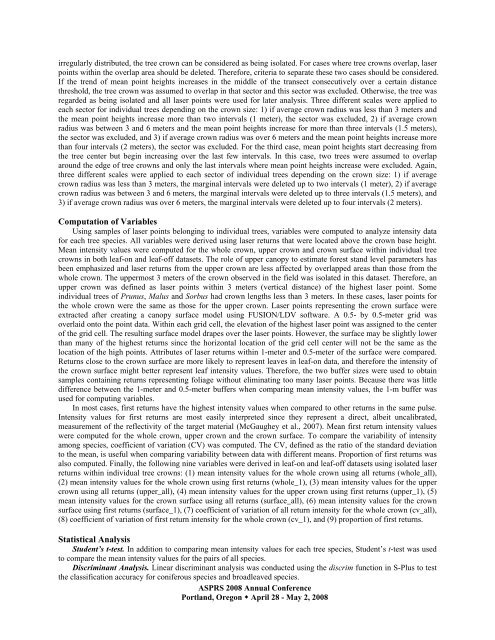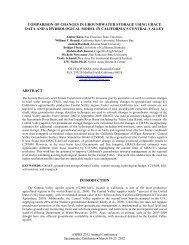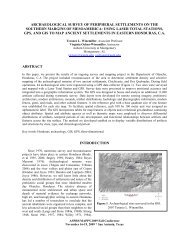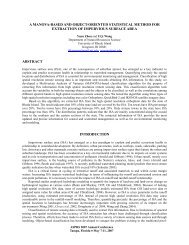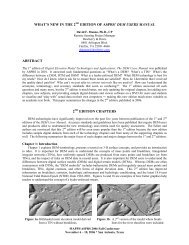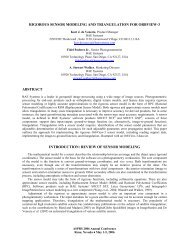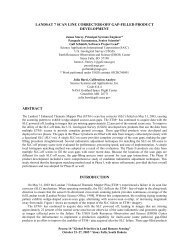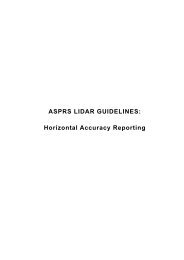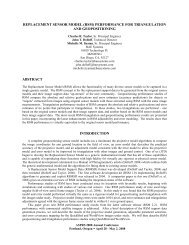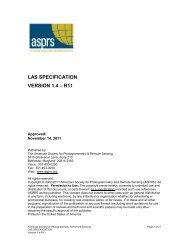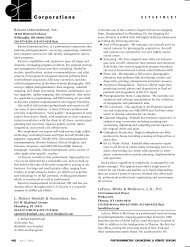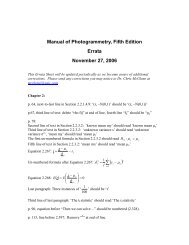Individual Tree Species Identification Using Lidar Intensity Data - asprs
Individual Tree Species Identification Using Lidar Intensity Data - asprs
Individual Tree Species Identification Using Lidar Intensity Data - asprs
You also want an ePaper? Increase the reach of your titles
YUMPU automatically turns print PDFs into web optimized ePapers that Google loves.
irregularly distributed, the tree crown can be considered as being isolated. For cases where tree crowns overlap, laser<br />
points within the overlap area should be deleted. Therefore, criteria to separate these two cases should be considered.<br />
If the trend of mean point heights increases in the middle of the transect consecutively over a certain distance<br />
threshold, the tree crown was assumed to overlap in that sector and this sector was excluded. Otherwise, the tree was<br />
regarded as being isolated and all laser points were used for later analysis. Three different scales were applied to<br />
each sector for individual trees depending on the crown size: 1) if average crown radius was less than 3 meters and<br />
the mean point heights increase more than two intervals (1 meter), the sector was excluded, 2) if average crown<br />
radius was between 3 and 6 meters and the mean point heights increase for more than three intervals (1.5 meters),<br />
the sector was excluded, and 3) if average crown radius was over 6 meters and the mean point heights increase more<br />
than four intervals (2 meters), the sector was excluded. For the third case, mean point heights start decreasing from<br />
the tree center but begin increasing over the last few intervals. In this case, two trees were assumed to overlap<br />
around the edge of tree crowns and only the last intervals where mean point heights increase were excluded. Again,<br />
three different scales were applied to each sector of individual trees depending on the crown size: 1) if average<br />
crown radius was less than 3 meters, the marginal intervals were deleted up to two intervals (1 meter), 2) if average<br />
crown radius was between 3 and 6 meters, the marginal intervals were deleted up to three intervals (1.5 meters), and<br />
3) if average crown radius was over 6 meters, the marginal intervals were deleted up to four intervals (2 meters).<br />
Computation of Variables<br />
<strong>Using</strong> samples of laser points belonging to individual trees, variables were computed to analyze intensity data<br />
for each tree species. All variables were derived using laser returns that were located above the crown base height.<br />
Mean intensity values were computed for the whole crown, upper crown and crown surface within individual tree<br />
crowns in both leaf-on and leaf-off datasets. The role of upper canopy to estimate forest stand level parameters has<br />
been emphasized and laser returns from the upper crown are less affected by overlapped areas than those from the<br />
whole crown. The uppermost 3 meters of the crown observed in the field was isolated in this dataset. Therefore, an<br />
upper crown was defined as laser points within 3 meters (vertical distance) of the highest laser point. Some<br />
individual trees of Prunus, Malus and Sorbus had crown lengths less than 3 meters. In these cases, laser points for<br />
the whole crown were the same as those for the upper crown. Laser points representing the crown surface were<br />
extracted after creating a canopy surface model using FUSION/LDV software. A 0.5- by 0.5-meter grid was<br />
overlaid onto the point data. Within each grid cell, the elevation of the highest laser point was assigned to the center<br />
of the grid cell. The resulting surface model drapes over the laser points. However, the surface may be slightly lower<br />
than many of the highest returns since the horizontal location of the grid cell center will not be the same as the<br />
location of the high points. Attributes of laser returns within 1-meter and 0.5-meter of the surface were compared.<br />
Returns close to the crown surface are more likely to represent leaves in leaf-on data, and therefore the intensity of<br />
the crown surface might better represent leaf intensity values. Therefore, the two buffer sizes were used to obtain<br />
samples containing returns representing foliage without eliminating too many laser points. Because there was little<br />
difference between the 1-meter and 0.5-meter buffers when comparing mean intensity values, the 1-m buffer was<br />
used for computing variables.<br />
In most cases, first returns have the highest intensity values when compared to other returns in the same pulse.<br />
<strong>Intensity</strong> values for first returns are most easily interpreted since they represent a direct, albeit uncalibrated,<br />
measurement of the reflectivity of the target material (McGaughey et al., 2007). Mean first return intensity values<br />
were computed for the whole crown, upper crown and the crown surface. To compare the variability of intensity<br />
among species, coefficient of variation (CV) was computed. The CV, defined as the ratio of the standard deviation<br />
to the mean, is useful when comparing variability between data with different means. Proportion of first returns was<br />
also computed. Finally, the following nine variables were derived in leaf-on and leaf-off datasets using isolated laser<br />
returns within individual tree crowns: (1) mean intensity values for the whole crown using all returns (whole_all),<br />
(2) mean intensity values for the whole crown using first returns (whole_1), (3) mean intensity values for the upper<br />
crown using all returns (upper_all), (4) mean intensity values for the upper crown using first returns (upper_1), (5)<br />
mean intensity values for the crown surface using all returns (surface_all), (6) mean intensity values for the crown<br />
surface using first returns (surface_1), (7) coefficient of variation of all return intensity for the whole crown (cv_all),<br />
(8) coefficient of variation of first return intensity for the whole crown (cv_1), and (9) proportion of first returns.<br />
Statistical Analysis<br />
Student’s t-test. In addition to comparing mean intensity values for each tree species, Student’s t-test was used<br />
to compare the mean intensity values for the pairs of all species.<br />
Discriminant Analysis. Linear discriminant analysis was conducted using the discrim function in S-Plus to test<br />
the classification accuracy for coniferous species and broadleaved species.<br />
ASPRS 2008 Annual Conference<br />
Portland, Oregon April 28 - May 2, 2008


